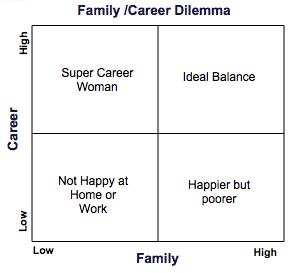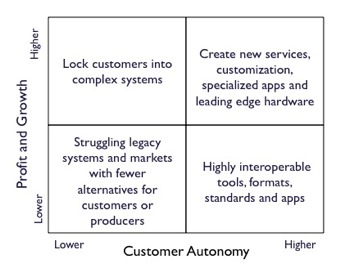In our client workshops we focus on helping teams identify their biggest challenges, and redefine tough dilemmas in ways that reveal underlying opportunities. And, often we’ll ask the individuals in a group to discuss their personal dilemmas. While there are dangers in delving into personal issues in a business setting, sharing issues that may be common to members of a work team quickly builds sympathy that improves group communication. (Keep in mind when we talk about dilemmas, we are talking about deep major tradeoffs between competing options, under conditions which are often beyond your control. We differentiate between decisions, problems and dilemmas here.)
Not surprisingly, many of us share the same dilemmas. While it is dangerous (for a man, especially) to generalize in this way, there is a recurring pattern to the dilemmas described by women in our classes. This dilemma is fundamentally about wanting or needing to do too many things in too little time. Some say they feel torn between family and job, between commitments to husband, children and aging parents on the one hand, and career goals and job demands on the other. Other individuals may use different words to describe similar circumstances. And, these conflicts naturally result in feelings of inadequacy at not being able to give enough in or another area of their busy lives.
 These client experiences came to mind recently when we read that women literally are becoming less happy. Since 1972 the General Social Survey of the National Opinion Research Council has tracked demographics and attitudes of Americans. According to their data, and that of some other recent surveys, women have become less happy in recent decades. Men, on the other hand are becoming relatively more joyful, especially as they age. This was reported in newspapers and a recent Time cover story about women.
These client experiences came to mind recently when we read that women literally are becoming less happy. Since 1972 the General Social Survey of the National Opinion Research Council has tracked demographics and attitudes of Americans. According to their data, and that of some other recent surveys, women have become less happy in recent decades. Men, on the other hand are becoming relatively more joyful, especially as they age. This was reported in newspapers and a recent Time cover story about women.
In her column, Blue Is The New Black New York Times columnist Maureen Dowd explores this phenomenon and looks at possible causes. As it turns out there are plenty of experts in the happiness business, and they’ve got opinions as to what underlies female gloominess. For example:
- Children: One expert points out that children make people less happy, both men and women. However, few survey respondents say they would rather have not had kids.
- Sex role differences: Women are often expected to shoulder the majority of home and child responsibilities. But recent research suggests that men continue to increase the amount of time they devote to household and child chores that were one women’s exclusive domain and in many marriages it approaches parity.
- Emotions: Women also may take success and defeat harder than men. Biologically, they may be emotionally more intense relative to men.
- Mixed cultural messages: Our culture sends women demoralizing messages about beauty and aging that are positively anxiety inducing.
- Choice: Overall women face an unhealthy amount of choices with the expectation that they will excel as workers, wives and moms. As Dowd puts it, ” When women stepped into male- dominated realms, they put more demands — and stress — on themselves. If they once judged themselves on looks, kids, hubbies, gardens and dinner parties, now they judge themselves on looks, kids, hubbies, gardens, dinner parties — and grad school, work, office deadlines and meshing a two-career marriage.”
That dilemma might be described as the needs of the self versus the needs of family, home and work. Or the conflict between our wants—to excel as career woman, mother and wife—and what we need to be spiritually and physically healthy. Our students and clients have diagrammed this challenge many times in our workshops . Often it looks like this. The demands of family are on one axis, the demands of work and career on the other.
For all of us the archetypal individual dilemma is to balance the effort we put into meeting the needs of others with the requirement to fulfill our own needs. When we feel like we are giving at home and work, and not getting enough time for ourself, burnout and unhappiness are more likely to follow.

The levels of unhappiness showing up in these surveys are evidence that women in our society may face a special dilemma. Or that the choices they are making in response to the dilemma of overwhelming demands and responsibilities are inadequate.
But that is our interpretation. What matters is that you consider and wrestle with your own dilemmas. And, that you describe them in your own language. For some, the family versus career example above neatly synthesizes what they are feeling. For others, that is too simplistic, or simply wide of the mark.
Let us suggest some homework. Try to define a personal dilemma for yourself. You’ll find instructions in the next post here.


 A new challenge for proprietary operating systems may be brewing in
A new challenge for proprietary operating systems may be brewing in